A summarizing review of what has been happening at the crypto markets of the past week. A look at trending sectors, liquidity, volatility, spreads and more. The weekly report in cooperation with market data provider Kaiko.
The last 7 days in the cryptomarkets:
- Price Movements: Tesla revealed that they have purchased $1.5B in Bitcoin, which instantly caused the price to shoot to a new all time high above $44k (and in the process, crashing several of the world's largest exchanges). Ethereum also reached a new ATH ahead of its CME futures debut.
- Trading Volume: The average trade size for ETH-USD markets is now nearly equal to that of BTC-USD, suggesting a recent influx of high-volume traders.
- Order Book Liquidity: Average market depth for ETH-USD has doubled on Coinbase since October.
- Volatility and Correlations: Extreme intraday volatility linked to Elon Musk has jolted markets twice in the past two weeks.
Ethereum hits new high ahead of CME futures debut

New all time highs, extreme intraday volatility, growing network activity, and the highest transaction fees ever—Ethereum has had quite the start to the new year. The crypto asset closed the week up nearly 23% after reaching a new all time high above $1'700. The volatility comes ahead of the debut of Ethereum futures on the Chicago Mercantile Exchange, a milestone that promises to improve the efficiency of markets and enable a wider range of investors to gain exposure to the asset through a regulated investment product. CME has invested heavily into diversifying their crypto offerings over the past year in response to rising demand from institutional investors.
The average ETH trade is nearly equal to the average BTC trade

ETH is not typically the first crypto-asset that professional investors trade which is why ETH trade sizes have historically been smaller on average than BTC trade sizes. Yet, we can observe similar trends for the two assets over the past few months, with average trade sizes now nearly equal. Of note is the peak in trade sizes for BTC-USD in the summer of 2019, which was when a mini-bull run for Bitcoin occurred, with prices crossing $10k. This further suggests that prices are closely tied with average trade size. To calculate this measure, we took the average trade size for 8 BTC-USD and ETH-USD trading pairs, which can be viewed here.
ETH market depth is increasing on Coinbase
Since October, there has been an uptrend in the quantity of ETH on Coinbase order books. This is notable considering BTC market depth has fallen on Coinbase, although the crypto asset has experienced similar extreme price movements. This suggests market depth is influenced by more than just price movements; the overall interest that market makers have for an asset and/or the actual supply of the asset available for market making activities also plays a role.
Market depth is one of the more complicated liquidity measures to analyze, and it is difficult to attribute changes to just one factor. Because spreads and slippage have improved over time for ETH-USD markets, the increase in market depth is further evidence that these markets are becoming more liquid. However, the increase has not occurred on every exchange. In our market review calender week 4, we took the sum of depth across 6 exchanges which showed an overall decline. However, Coinbase is one of the most important ETH-USD markets, which is why the upwards trend in depth is notable (Coinbase has 37% of total market share of volume for ETH-USD).
Elon Musk is to thank for Bitcoin's volatility
Bitcoin's two extreme intraday volatility events over the past couple of weeks were both linked to Musk's interest in the crypto asset. His ability to move markets, both directly by tweeting, and indirectly by releasing news about Tesla's historic BTC purchase, have shaken markets unlike any event in recent history. The historic nature of his purchase should not be underestimated and will likely have a significant impact on markets in the near future.






